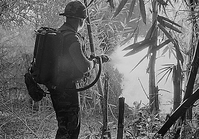








A flamethrower is a mechanical incendiary device designed to project a long, controllable stream of fire. They were first used during World War I, and widely used in World War II.
Some flamethrowers project a stream of ignited flammable liquid; some project a long gas flame. Most military flamethrowers use liquids, but commercial flamethrowers tend to use high-pressure propane and natural gas, which is considered safer. They are used by the military and by people needing controlled burning capacity, such as in agriculture (e.g., sugar cane plantations) or other such land management tasks. They can be designed to be either carried by the operator or mounted on a vehicle.
Early 20th century
The English word 'flamethrower' is a loan-translation of the German word Flammenwerfer, since the modern flamethrower was first invented in Germany. The first flamethrower, in the modern sense, is usually credited to Richard Fiedler. He submitted evaluation models of his Flammenwerfer to the German Army in 1901. The most significant model submitted was a man-portable device, consisting of a vertical single cylinder 4 feet (1.2 m) long, horizontally divided in two, with pressurized gas in the lower section and flammable oil in the upper section. On depressing a lever the propellant gas forced the flammable oil into and through a rubber tube and over a simple igniting wick device in a steel nozzle. The weapon projected a jet of fire and enormous clouds of smoke some 20 yards (18 m). It was a single-shot weapon—for burst firing, a new igniter section was attached each time.
Using fire in a World War I battle predated actual flamethrower use, with a petrol spray being ignited by an incendiary bomb in the Argonne-Meuse sector in October 1914.
It was not until 1911 that the German army accepted their first real flamethrowing device, creating a specialist regiment of twelve companies equipped with Flammenwerferapparaten.Despite this, the weapon went unused in World War I until February 26, 1915, when it was briefly used against the French outside Verdun. On July 30, 1915, it was first used in a concerted action, against British trenches at Hooge, where the lines were just 4.5 m (4.9 yd) apart—even there, the casualties were caused mainly by soldiers being flushed into the open and being shot by more conventional means rather than from the fire itself.
The flamethrower had other limitations: it was cumbersome and difficult to operate and could only be safely fired from a trench, which limited its use to areas where the opposing trenches were less than the maximum range of the weapon, namely 18 m (20 yd) apart—which was not a common situation; the fuel would also only last for about 2 minutes).
Nevertheless, the German army continued deploying flamethrowers during the war in more than 300 battles, usually in teams of 6.
British forces in the Battle of the Somme used experimental weapons called "Livens Large Gallery Flame Projector", named for their inventor, a Royal Engineers officer William Howard Livens.This weapon was enormous and completely non-portable. Livens later invented the Livens Projector, these were in effect crude mortars firing large bombs filled with incendiary liquid. A little later the weapon was adapted to project canisters of poison gas. Hundreds, or even thousands, of projectors firing almost simultaneously, would produce an instant cloud of poison gas on the target.
In the interwar period, at least four flamethrowers were used in the Chaco War by the Bolivian Army, during the unsuccessful assault on the Paraguayan stronghold of Nanawa in 1933.
The flamethrower was extensively used during World War II. In 1939, the Wehrmacht first deployed man-portable flamethrowers against the Polish Post Office in Danzig. Subsequently, in 1942, the U.S. Army introduced its own man-portable flamethrower. The vulnerability of infantry carrying backpack flamethrowers and the weapon's short range led to experiments with tank-mounted flamethrowers (flame tanks), which were used by many countries.